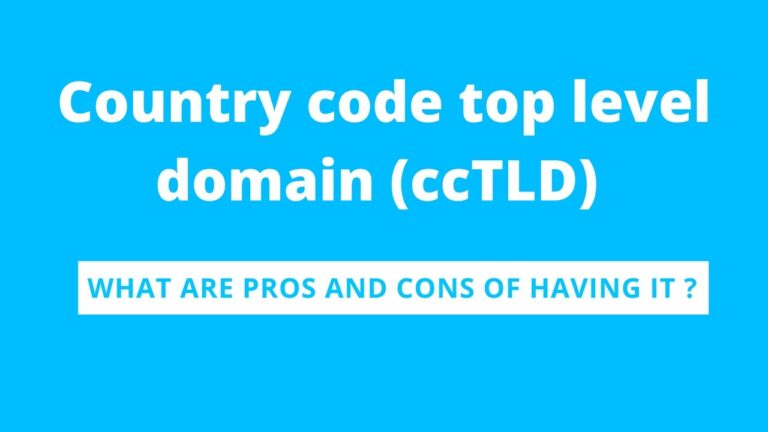The Influence of Top-Level Domains (TLDs) on SEO Ranking is an article that explores the correlation between the choice of top-level domains and search engine optimization (SEO) rankings. Through an analysis of various TLD options, this article highlights the impact that TLDs can have on a website’s visibility and ranking in search engine results. By understanding how TLDs influence SEO ranking, website owners and businesses can make informed decisions regarding their domain choices to optimize their online presence and improve their organic search performance.
The Importance of Top-Level Domains (TLDs)
From website URLs to SEO ranking, TLDs play a critical role in the success of online businesses. Understanding the significance of TLDs is crucial for optimizing your website’s visibility and reaching your target audience effectively. This article delves into the various aspects of TLDs and their influence on SEO ranking, helping you make informed decisions when choosing the right TLD for your website.
TLDs in Website URLs
TLDs, the last segment of a website’s URL, have become integral components of online identity. They provide essential information about the website’s purpose, location, or industry. With the right TLD, you can convey relevant information and engage with your target audience more effectively.
The Role of TLDs in SEO Ranking
TLDs have a significant impact on SEO ranking as search engines evaluate the relevance, authority, and user experience associated with a website. Understanding how TLDs influence these factors can help you optimize your website and enhance its visibility in search engine results.
Relevance of TLD to Website Content
Choosing a TLD that aligns with your website’s content can positively impact its SEO ranking. For example, using “.edu” for educational institutions or “.gov” for governmental websites helps search engines identify the purpose and context of your website. Incorporating relevant TLDs into your URL structure helps search engines and users understand the nature of your website.
Authority and Trustworthiness of TLDs
Search engines consider TLDs as a factor in determining the authority and trustworthiness of a website. Traditional TLDs such as “.com,” “.net,” and “.org” have established credibility over the years and are often preferred by search engines. However, newer TLDs can also be trustworthy if they are associated with reputed organizations or industries.
TLDs and User Experience
TLDs also contribute to the overall user experience of a website. Users tend to have preconceived expectations about websites with certain TLDs. For example, “.edu” TLDs are often associated with educational resources, while “.gov” TLDs are linked to official government websites. Aligning your TLD with user expectations helps improve their experience and increases the likelihood of user engagement.
Geographical Targeting with TLDs
If your website caters to specific geographical regions, utilizing country code Top-Level Domains (ccTLDs) can significantly enhance your SEO ranking. Search engines identify these TLDs as indicators of local relevance, boosting your website’s visibility in targeted regions. By leveraging ccTLDs, businesses can effectively reach their intended audience and gain a competitive edge in local search results.
Domain Extensions and SEO
Understanding various types of TLDs is essential when considering their impact on SEO ranking. Each domain extension serves a specific purpose and can influence your website’s visibility and targeting capabilities.
Generic Top-Level Domains (gTLDs)
gTLDs are widely recognized TLDs that are not associated with specific countries or regions. Examples include “.com,” “.net,” and “.org.” These TLDs are versatile and can be used for global, industry-specific, or brand-based websites. While they lack the geographical targeting benefits of ccTLDs, gTLDs offer broader reach and familiarity for international audiences.
Country Code Top-Level Domains (ccTLDs)
ccTLDs are two-letter domain extensions corresponding to specific countries or territories. Examples include “.us” for the United States, “.uk” for the United Kingdom, and “.de” for Germany. Utilizing ccTLDs allows businesses to target specific regions more effectively and improve their visibility in local search results. Search engines consider ccTLDs as strong signals for geographical relevance.
New Generic Top-Level Domains (ngTLDs)
ngTLDs are relatively recent additions to the TLD landscape. These domain extensions provide businesses with more industry-specific or purpose-driven choices. Examples include “.photography” for photographers, “.shop” for online stores, or “.travel” for travel-related websites. However, search engines may not give the same weightage to ngTLDs as they do to traditional TLDs when assessing authority and trustworthiness.
Brand Top-Level Domains (btTLDs)
btTLDs are TLDs associated with specific brands or organizations. These TLDs offer enhanced brand identity and exclusivity. For example, “.apple” is exclusively used by Apple Inc. While btTLDs are not commonly available to all businesses, their impact on brand recognition and customer perception can be significant within specific industries.

This image is property of images.pexels.com.
Choosing the Right TLD for SEO
When selecting a TLD for your website, consider several factors to ensure it aligns with your SEO goals and business objectives.
Matching TLD with Website Purpose and Target Audience
To maximize your website’s visibility and relevance, choose a TLD that accurately reflects your website’s purpose and target audience. Consider what your website offers, who your target audience is, and what they expect from your website. For example, a website offering travel services may benefit from a TLD like “.travel” to instantly convey its purpose.
Evaluating TLDs for Authority and Reputation
Research the authority and reputation associated with different TLDs to make an informed decision. Traditional gTLDs like “.com” and “.org” generally have a strong history and established credibility. Evaluate ngTLDs and btTLDs based on the reputation of the organizations or industries they represent. This evaluation helps ensure that the chosen TLD promotes trust and enhances your website’s reputation.
Considering Geographical Targeting with TLDs
If your business relies on geographical targeting, utilizing ccTLDs enables you to strengthen your local SEO strategy. Evaluate the importance of local search traffic for your business and consider investing in ccTLDs that align with your target markets. These TLDs provide a clear signal to search engines about your geographic relevance, boosting your visibility in local search results.
TLDs and Local SEO
For businesses targeting specific local markets, understanding how TLDs impact local SEO is crucial.
Local SEO Benefits of ccTLDs
ccTLDs are invaluable for local SEO as they clearly indicate geographic targeting. When users search for local services or products, search engines prioritize websites with ccTLDs that match the user’s location. Therefore, incorporating ccTLDs related to your target markets enhances your website’s visibility and increases the likelihood of attracting local customers.
Localizing Content with gTLDs
While gTLDs are not inherently associated with specific regions, they can still be leveraged for local SEO. By localizing content and targeting specific regional keywords, businesses can optimize gTLDs to attract local search traffic. This approach allows businesses to maintain a global online presence while catering to multiple local markets.
Using ngTLDs for Niche Local Markets
ngTLDs can be advantageous for businesses targeting niche local markets. For example, a local bakery with a “.bake” TLD can create a unique and memorable online presence. By leveraging ngTLDs, businesses can differentiate themselves within specific industries and regions, attracting targeted local customers.
TLDs and International SEO
Expanding your business globally requires effective international SEO strategies. TLD selection plays a pivotal role in reaching an international audience.
Global SEO Strategies with gTLDs
gTLDs are ideal for businesses with a global presence. Their familiarity and broad reach allow businesses to attract international customers without relying on country-specific TLDs. By optimizing gTLDs for global SEO, businesses can target keywords and strategies that transcend geographical boundaries, ensuring visibility in multiple markets.
Geographical Targeting with ccTLDs
For businesses with specific country or language preferences, ccTLDs are instrumental in targeting international markets. Utilizing country-specific TLDs helps search engines understand the intended audience, language, and geographic relevance of a website. By investing in multiple ccTLDs, businesses can tailor their content to specific countries, languages, and cultures, enhancing their international SEO efforts.
Multilingual Websites and gTLDs
Websites targeting multicultural and multilingual audiences can leverage gTLDs in their international SEO strategies. By optimizing gTLDs with language-specific content and keywords, businesses can target diverse markets without the need for country-specific TLDs. This approach offers flexibility and ensures global visibility for websites catering to multiple languages.
TLDs and Branding
TLDs contribute significantly to a website’s branding efforts, enhancing brand identity and recognition.
Enhancing Brand Identity with btTLDs
btTLDs offer exclusive branding opportunities for organizations committed to establishing a distinct online presence. By using a btTLD associated with their brand name, organizations can reinforce their brand identity and ensure consistency across their online platforms. However, as btTLDs are limited and often require significant investment, they may not be accessible to all businesses.
The Impact of ngTLDs on Brand Recognition
ngTLDs provide branding opportunities for businesses seeking a unique online identity. By incorporating ngTLDs related to their industry or purpose, businesses can differentiate themselves and capture the attention of their target audience. While ngTLDs may not have the same initial recognition as traditional TLDs, strategic branding efforts can establish their credibility and increase brand recognition over time.
Maintaining Brand Consistency with TLDs
Consistency across online platforms is crucial for brand recognition. By using consistent TLDs across different websites and online properties, businesses can reinforce their brand identity and create a cohesive online presence. Whether it is using gTLDs for global reach or ccTLDs for local targeting, maintaining brand consistency through TLD selection helps strengthen brand recognition and trust.
TLDs and User Perception
TLDs influence user perception of websites, impacting user trust, familiarity, and behavior.
User Trust and TLD Credibility
Users often associate certain TLDs with credibility and trustworthiness. Traditional TLDs like “.com” are widely trusted and recognized, while lesser-known or uncommon TLDs may raise skepticism. By choosing TLDs that align with user expectations and preconceived notions of trust, businesses can establish a positive impression and encourage user engagement.
User Familiarity with TLDs
Users are more likely to trust and engage with websites that have familiar TLDs. Familiarity breeds confidence, making users feel more comfortable exploring and interacting with a website. Understanding the level of familiarity associated with different TLDs within your target audience helps you select a TLD that resonates well and encourages user engagement.
User Behavior Influenced by TLDs
TLDs can influence user behavior, affecting click-through rates, browsing patterns, and conversions. A relevant and trustworthy TLD can attract users, increase their time on site, and boost the likelihood of conversions. Conversely, an irrelevant or suspicious TLD may lead users to abandon the website prematurely. By carefully selecting a TLD that resonates with your target audience, businesses can positively influence user behavior and boost overall website performance.
Case Studies on TLDs and SEO Ranking
Analyzing the impact of TLDs on SEO ranking by studying case studies provides valuable insights into their influence.
The Effect of TLDs on SEO Performance of Major Websites
Examining the SEO performance of major websites across different industries uncovers the role TLDs play in their rankings. By identifying patterns and trends, businesses can learn from successful SEO strategies and optimize their TLD choices accordingly. Case studies help businesses understand the tangible benefits of implementing the right TLDs for their SEO efforts.
Comparing TLDs’ Impact on Businesses in Different Industries
Different industries may experience diverse outcomes based on their TLD selection. By comparing the SEO ranking performance of businesses within the same industry but with different TLDs, businesses can identify the most effective TLD for their specific niche. These comparisons highlight the industry-specific advantages and challenges associated with different TLDs, guiding businesses in their decision-making process.
Optimizing TLDs for SEO
To maximize the SEO potential of TLDs, businesses should consider various optimization strategies.
Setting up Domain Structure for SEO Success
Carefully structuring your domain and URL hierarchy can enhance the SEO impact of TLDs. Utilize meaningful subdomains, directories, and page URLs to create a logical and navigable website structure. By optimizing your website’s architecture, search engines can better understand your website’s content, improving its visibility and ranking.
Utilizing Keywords in TLDs
Incorporating relevant keywords into your TLDs can further enhance your website’s SEO. While it is important to strike a balance between keyword optimization and user-friendliness, strategically using keywords in TLDs can give search engines additional context about your website’s purpose. This approach helps you rank higher in keyword-specific searches and attracts targeted traffic.
Maximizing TLD Relevance in URL Structure
Aligning your TLD with your website’s content and URL structure is crucial for SEO success. Ensure that your TLD, domain, directory, and page URLs reflect the overall purpose and relevance of your website. Consistency in your URL structure enhances search engines’ understanding of your website’s content, resulting in improved rankings for relevant search queries.
In conclusion, TLDs play an integral role in the SEO ranking performance of websites. Understanding the various factors that influence SEO and how TLDs impact those factors empowers businesses to make informed decisions when choosing the perfect TLD for their website. By considering relevance, authority, user experience, and geographical targeting, businesses can optimize their TLD selection and strengthen their online presence, attracting the right audience, and improving their SEO ranking.




